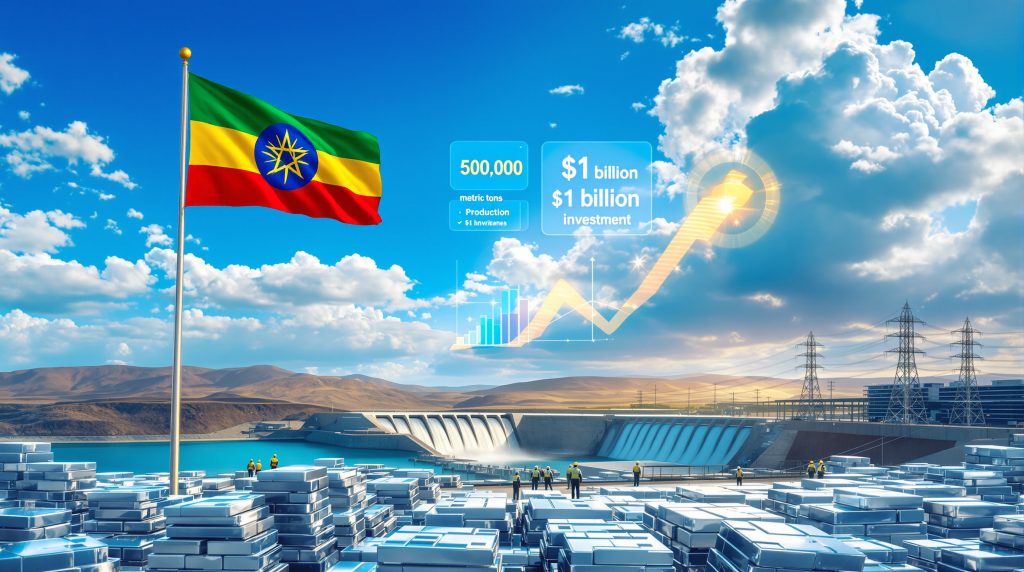Ethiopia's industrial landscape is undergoing a dramatic transformation, marked by ambitious manufacturing partnerships that could reshape the nation's economic trajectory. The recent preliminary Ethiopia aluminum smelter plant agreement between Ethiopian Investment Holdings and aluminum giant Rusal represents more than just another foreign investment deal—it signals Ethiopia's emergence as a serious contender in global heavy industry.
The proposed aluminum smelter facility, with its planned annual production capacity of 500,000 metric tons, positions Ethiopia to enter the ranks of significant aluminum-producing nations. This development comes at a time when global supply chains are increasingly seeking diversification away from traditional production centers, creating opportunities for emerging economies with competitive advantages. Furthermore, these developments align with broader industry evolution trends that emphasise sustainable production methods and strategic geographic positioning.
The Role of Energy Infrastructure in Industrial Development
Energy-intensive industries like aluminum smelting require consistent, affordable power supplies to remain economically viable. Ethiopia's strategic advantage lies in its expanding hydroelectric capacity, which provides the foundation necessary for large-scale metal production operations.
The timing of this agreement aligns with Ethiopia's broader energy infrastructure development initiatives. Hydroelectric power offers aluminum producers significant cost advantages compared to fossil fuel-dependent facilities, particularly as global energy markets continue to experience volatility. In addition, this approach supports energy transition dynamics that are reshaping industrial power requirements worldwide.
Production costs in aluminum smelting are heavily influenced by electricity prices, which typically account for 25-40% of total production expenses. Access to low-cost renewable energy sources creates a sustainable competitive advantage that can persist throughout the facility's projected 50-year operational lifespan.
Foreign Investment Patterns in East African Manufacturing
The Rusal agreement follows a pattern of substantial industrial investments in Ethiopia throughout 2024. The country secured a $2.5 billion fertilizer manufacturing agreement with Nigeria's Dangote Group in August, followed by a nuclear power plant action plan with Russia in September.
These developments indicate Ethiopia's growing attractiveness as an industrial destination in East Africa. The government's investment-friendly policies and strategic geographic position between African markets and global trade dynamics make it an appealing location for manufacturers seeking to establish continental production hubs.
Russian partnerships in African resource development have become increasingly prominent as companies seek new markets and investment opportunities. This trend reflects broader geopolitical shifts in international trade relationships and industrial cooperation agreements. For instance, Rusal's recent expansion into African markets demonstrates the company's strategic commitment to continental industrial development.
Technical Specifications and Production Capacity Analysis
The proposed Ethiopian aluminum facility represents a significant addition to global production capacity. With an annual output target of 500,000 metric tons, the plant would contribute meaningfully to international aluminum supplies while establishing Ethiopia's presence in global metal markets.
Production Capacity and Market Positioning
The facility's scale places it among major aluminum production operations worldwide. For context, global aluminum production exceeds 65 million metric tons annually, making Ethiopia's planned contribution roughly 0.8% of total output once operational.
This capacity level positions the facility as a medium-to-large scale operation by international standards. The production target suggests sophisticated smelting technology and substantial infrastructure investment beyond the $1 billion first-phase commitment.
The phased development approach over 3-4 years indicates a systematic scaling strategy designed to manage technical complexity and capital deployment efficiently. This timeline aligns with typical large-scale smelter construction projects, which require extensive site preparation, equipment installation, and operational testing phases.
Investment Structure and Implementation Framework
The memorandum of understanding outlines a structured approach to project development, beginning with site identification and comprehensive feasibility studies. This methodical planning phase reduces execution risks and ensures optimal facility placement and design.
The $1 billion first-phase investment suggests sophisticated production technology and substantial supporting infrastructure. Modern aluminum smelters require specialised equipment including reduction cells, power rectification systems, and materials handling facilities, all of which contribute to significant capital requirements.
Key implementation elements include:
- Site selection based on power access, transportation connectivity, and regulatory environment
- Feasibility assessments covering technical, economic, and environmental factors
- Infrastructure development including power transmission and logistics systems
- Technology transfer and local workforce development programmes
- Regulatory compliance and environmental impact mitigation measures
The 50-year operational timeline reflects the long-term nature of aluminum smelting investments and the substantial infrastructure required. This extended horizon provides stability for both the investor and the Ethiopian economy while ensuring adequate time to recover capital investments.
Comparative Analysis with Regional Aluminum Initiatives
Ethiopia's aluminum venture occurs within a broader context of African industrial development and metal production expansion. While specific details of comparable projects require careful verification, the Ethiopian initiative represents part of a continent-wide trend toward value-added manufacturing.
| Project Aspect | Ethiopia-Rusal Initiative | Typical African Industrial Projects |
|---|---|---|
| Production Scale | 500,000 metric tons annually | Varies significantly by sector |
| Investment Phase 1 | $1 billion committed | Range typically $500M-$3B |
| Development Period | 3-4 years planned | Often 4-6 years actual |
| Energy Source | Hydroelectric focus | Mixed renewable/conventional |
| Operational Horizon | 50 years projected | Typically 20-30 years |
Competitive Advantages in African Context
Several factors distinguish Ethiopia's aluminum initiative from other regional manufacturing projects. The combination of renewable energy access, government investment support, and strategic geographic positioning creates a unique value proposition for heavy industry development.
The country's landlocked status presents logistics challenges but also opportunities for regional trade integration. Aluminum products can be transported efficiently overland to multiple African markets, supporting intra-continental trade development goals. Furthermore, this approach aligns with South African beneficiation strategies that emphasise value-added processing within the continent.
Ethiopia's industrial policy framework emphasises technology transfer and skills development, potentially creating lasting economic benefits beyond direct production activities. This approach aligns with African Union industrialisation strategies focused on building manufacturing capabilities across the continent.
Economic Development Implications for Ethiopia
The aluminum smelter project carries significant potential for Ethiopian economic development across multiple dimensions. Beyond direct investment flows, the facility could catalyse broader industrial ecosystem development and economic diversification. However, the Ethiopia aluminum smelter plant agreement represents just one aspect of the country's broader industrialisation strategy.
Employment Generation and Skills Development
Large-scale aluminum production typically requires substantial direct employment across various skill levels. Modern smelting operations demand both technical specialists and production workers, creating opportunities for workforce development and technology transfer.
The preliminary agreement's emphasis on comprehensive feasibility studies suggests attention to human resource requirements and training needs. Successful implementation would likely involve partnerships with Ethiopian educational institutions and technical training programmes.
Key employment considerations include:
- Direct operational positions in smelting, maintenance, and quality control
- Indirect employment through supply chain and logistics services
- Technical skills development in metallurgy and industrial processes
- Management and administrative roles requiring advanced capabilities
- Construction and installation jobs during the development phase
Export Revenue and Foreign Exchange Impact
Aluminum production for export markets could provide substantial foreign exchange earnings for Ethiopia's economy. The facility's 500,000 metric ton annual capacity represents significant export potential, particularly given growing aluminum demand in regional and global markets.
The long-term nature of aluminum markets provides revenue stability compared to more volatile commodities. This characteristic supports economic planning and foreign exchange management efforts, potentially contributing to currency stability over time.
Export-oriented aluminum production also supports Ethiopia's broader economic diversification goals. Moving beyond traditional agricultural exports toward manufactured goods represents a strategic shift toward higher value-added economic activities.
Global Supply Chain Implications
Ethiopia's entry into aluminum production occurs during a period of supply chain reassessment across multiple industries. The facility represents geographic diversification of production capacity and potential alternatives to established supply sources. Consequently, these developments are likely to be discussed at upcoming industry gatherings such as the global resources expo where supply chain innovations are regularly showcased.
Supply Chain Diversification Trends
Global aluminum markets have historically concentrated production in specific regions, creating potential supply vulnerabilities. New production capacity in Africa contributes to geographic distribution and supply chain resilience.
The renewable energy component of Ethiopia's aluminum production aligns with growing sustainability requirements from end-users. Many manufacturers now prioritise low-carbon aluminum sources, creating market premiums for environmentally responsible production.
Regional supply chain benefits include:
- Reduced transportation costs for African aluminum consumers
- Enhanced supply security for continental manufacturing industries
- Opportunities for regional value chain integration
- Support for African Continental Free Trade Area objectives
- Technology transfer and industrial capability development
The establishment of aluminum production capacity in Ethiopia represents a strategic shift in global supply geography, leveraging Africa's renewable energy potential while supporting continental industrialisation goals.
Environmental and Sustainability Considerations
Modern aluminum smelting increasingly emphasises environmental responsibility and carbon footprint reduction. Ethiopia's hydroelectric power advantage positions the facility to produce low-carbon aluminum, meeting growing market demand for sustainable materials.
Environmental considerations include water management, waste minimisation, and air quality protection. The feasibility study phase provides opportunities to incorporate best practices in environmental management and community engagement.
Sustainable production practices also support long-term market competitiveness as environmental regulations and customer requirements continue evolving globally.
Implementation Challenges and Risk Factors
Despite positive economic prospects, the aluminum smelter project faces several implementation challenges that could affect timeline, costs, or ultimate success. Understanding these risks enables better project planning and mitigation strategies.
Infrastructure and Logistics Requirements
Aluminum smelting requires substantial supporting infrastructure beyond the production facility itself. Power transmission, water supply, waste management, and transportation systems all require careful planning and investment.
Ethiopia's landlocked geography creates specific logistics challenges for raw material imports and finished product exports. Efficient transportation corridors to port facilities become critical for operational success and cost competitiveness.
Infrastructure development needs include:
- Dedicated power transmission lines with sufficient capacity and reliability
- Transportation networks capable of handling heavy industrial materials
- Port access arrangements for raw material imports and product exports
- Water supply systems for industrial processes and cooling requirements
- Telecommunications and digital infrastructure for modern operations
Regulatory and Compliance Considerations
International aluminum projects must navigate complex regulatory environments covering environmental protection, labour standards, trade compliance, and financial regulations. The preliminary agreement phase allows time to address these requirements systematically.
Given the Russian partnership, international sanctions compliance requires particular attention. Trade restrictions and financial regulations could impact project financing, technology transfer, or market access if not properly managed.
The 50-year operational timeline necessitates stable regulatory frameworks and predictable business conditions. Long-term policy consistency becomes crucial for investor confidence and project viability.
Investment Opportunities and Market Implications
The Ethiopian aluminum project creates multiple investment opportunities across supporting industries and services. Understanding these possibilities helps stakeholders evaluate broader market implications and participation options.
Supporting Industry Development Potential
Large-scale aluminum production often catalyses downstream manufacturing development. Industries such as automotive components, construction materials, packaging, and consumer goods could benefit from local aluminum supply.
The project may also create opportunities in supporting services including logistics, maintenance, technical services, and specialised equipment supply. These ancillary markets often provide substantial economic benefits complementing direct production activities.
Investment opportunities span multiple sectors:
- Equipment and technology suppliers for smelting and processing systems
- Construction and engineering services for facility development
- Transportation and logistics for materials handling and distribution
- Downstream processing for value-added aluminum products
- Energy infrastructure supporting industrial power requirements
Market Implications for Aluminum Pricing
New production capacity typically influences regional pricing dynamics and supply-demand balances. Ethiopia's aluminum output could affect pricing in African markets while contributing to global supply growth.
The renewable energy advantage may create pricing differentiation opportunities if carbon-conscious customers pay premiums for low-emission aluminum. This trend could enhance project economics beyond basic commodity pricing.
Long-term market success depends on operational efficiency, quality standards, and customer relationship development. Establishing reliable supply relationships takes time but provides stable revenue foundations once achieved.
Frequently Asked Questions About the Ethiopian Aluminum Initiative
When will aluminum production begin at the Ethiopian facility?
Based on the stated 3-4 year development timeline, initial production could potentially commence between 2028-2029, assuming the preliminary agreement advances to final contracts and construction proceeds as planned.
How will Ethiopia source raw materials for aluminum production?
The project will likely require imported alumina, the refined raw material used in aluminum smelting. Ethiopia's access to regional shipping routes and potential domestic bauxite resources could influence sourcing strategies and supply chain development.
What makes Ethiopia competitive for aluminum smelting compared to other locations?
Ethiopia's primary advantages appear to include access to renewable hydroelectric power, competitive operational costs, government investment support, and strategic positioning for African market access. These factors combine to create potentially attractive production economics.
How significant is 500,000 metric tons of annual aluminum production?
This production level represents a meaningful addition to African aluminum capacity while contributing approximately 0.8% to global annual production. The scale positions Ethiopia among medium-to-large aluminum producing operations internationally.
Future Implications for African Industrial Development
Ethiopia's aluminum venture represents more than an isolated industrial project. It exemplifies broader trends toward African manufacturing development and value-added production capabilities that could reshape continental economic patterns. Moreover, successful implementation of the Ethiopia aluminum smelter plant agreement could serve as a model for similar initiatives across the continent.
Regional Integration and Industrial Cluster Development
Successful aluminum production could encourage additional manufacturing investments in related industries. Industrial clusters often develop around anchor facilities, creating synergies and supporting infrastructure that benefits multiple operations.
The African Continental Free Trade Area framework supports regional industrial development by reducing trade barriers and encouraging continental supply chain integration. Ethiopia's aluminum production could serve markets across Africa while supporting broader industrialisation goals.
Technology transfer benefits extend beyond direct production knowledge to include project management, industrial engineering, and technical skills that apply across manufacturing sectors.
Long-term Strategic Positioning in Global Markets
Ethiopia's emergence as an aluminum producer reflects changing global economic geography and new opportunities for developing economies to participate in industrial value chains. Success in aluminum could encourage expansion into other metal production or downstream manufacturing activities.
The renewable energy foundation for aluminum production aligns with global sustainability trends and positions Ethiopia advantageously as environmental requirements continue tightening across international markets. Furthermore, details about similar initiatives can be found in reports about Ethiopia's broader industrial partnerships.
Future expansion possibilities depend on project success, market conditions, and continued infrastructure development. The 50-year operational horizon provides substantial time for capacity optimisation and potential scaling opportunities.
Disclaimer: This analysis is based on publicly available information about preliminary agreements and projected developments. Actual project outcomes may differ from current plans due to technical, financial, regulatory, or market factors. Readers should verify current project status and conduct independent research before making investment or business decisions related to Ethiopian aluminum production.
The Ethiopia aluminum smelter plant agreement with Rusal represents a significant development in African industrial capabilities and global supply chain evolution. While challenges remain, the project's potential for economic development and market impact makes it a noteworthy addition to continental manufacturing capacity. Success will depend on effective execution of technical, financial, and operational requirements throughout the extended development and operational phases ahead.
Interested in Aluminium and Mining Investment Opportunities?
Discovery Alert's proprietary Discovery IQ model delivers instant alerts on significant mineral discoveries across the ASX, transforming complex mining data into actionable investment insights for both short-term traders and long-term investors. Start your 30-day free trial today and discover why major mineral discoveries can generate exceptional returns by exploring Discovery Alert's discoveries page showcasing historic success stories.




